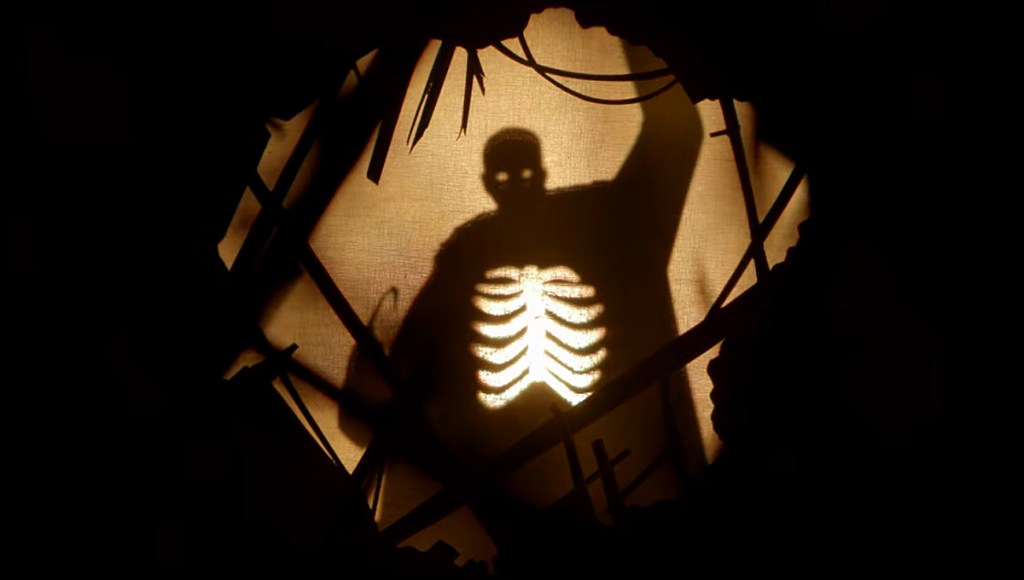
Ready for a tortured metaphor? Okay let’s proceed. Imagine a lake. There’s a fair amount of water and stuff that lives in it, maybe people fish or swim or shoot fireworks over it. There’s a lot to be said for a good lake. But you’ll never catch a swordfish in a lake. You’ll never go surfing. You’ll never get caught in a riptide.
Now imagine you’re God. I did say this was a tortured metaphor. Imagine you’re God and you’re trying to make an ocean. What you, God, won’t do is put a lot of lakes in the same area and call it an ocean just because there’s a lot of water in a given square footage. An ocean is about depth. And depth is where the real monsters live.
Candyman has been described in press releases as a “spiritual successor” to the 1992 classes, but far as I can tell, it’s really just a direct sequel. It follows up-and-coming Chicago artist Anthony McCoy (Yahya Abdul-Mateen II) as he, in search of a subject that will please his racially insensitive and arguably exploitative art scene benefactors, uncovers the urban legend Candyman, slowly becoming consumed with the story’s reflection of the black low-income Chicago community and his own history within it.
Candyman wants to be about a lot of things. The legacy of racial trauma, the relationship between the culture industry and misery, the nature of folklore, the failure of intellectualism to accurately describe horror, housing discrimination, police brutality, whether broken institutions can be changed from within…the problem is that each one of those issues is oceanic. Each one has an infinite amount of depth to plumb. But what Nia DaCosta, Jordan Peele, and Win Rosenfeld have done is provide us with a series of lakes—attractive and interesting environments that nevertheless have no connection to each other and into which you can only go so far.
As if that weren’t enough, there are several unintentional run-off ponds we have to wade through: Anthony’s art dealer girlfriend Brianna (Teyonah Parris) has a suggested subplot involving her dead father that goes nowhere. Characters that seem peripheral become very important but remain motiveless, and characters that seem important become peripheral. I’m still puzzling over plot logistics I can’t talk about without spoiling the movie, as well as two concurrent scenes, one where Anthony is talking to a cynical art critic, and another where his girlfriend is visiting her brother, where the critic and Brianna are both wearing the same shirt. I have no idea what I’m supposed to make of that.
I was extremely excited for this movie. Its shadow puppet trailer, which you can watch here (https://www.youtube.com/watch?v=QW5CfkUh_uw), is my favorite trailer of all time. It is eerie, imaginative, simple, relevant, and accurately describes the folkloric nature of Candyman as a character as well as the racial injustice at the core of his story. It is art.
The trailer’s greatest statement, though, is that nobody in this country has better horror stories to tell than black people. The history of American horror has largely focused on white people, itself an escapist cultural trend that allows us to continue to ignore the ghoulish experiences of black people over the entire history of this country. In the trailer are abstract depictions of James Byrd Jr., who was dragged behind a car to his death by three unrepentant white supremacists in the 90s, and George Stinney Jr., at 14 the youngest recorded person ever executed in the U.S. for a sham murder conviction in the 40s. He was so small that he had to sit on a Bible to fit in the electric chair. I’m not sure I’ve seen any singular image that captures the vibrating fury of this history better than the hulking, bloodied ghost of a black man in an abandoned Chicago alleyway, his head occluded behind an angry swarm of bees.
Candyman is very clearly made with its heart in the right place. It has a familiarity with and respect for the Chicago neighborhoods it depicts, makes good use of excellent actors, and has moments that hint at the extremely important movie this could have been. But in order to get there, it had to do what the trailer does: bring us out to sea, where your world becomes a flat, cold, slightly malevolent expanse in every direction. As it is, Candyman doesn’t take us anywhere we can’t still see the shore.
6/10. That’s a D-! Ugh. +6 for trying, and for great Chicago cityscapes. -2 for too many lakes, -1 for being needlessly confusing, and -1 for terrible advice about when to get that infected bee sting checked out.




